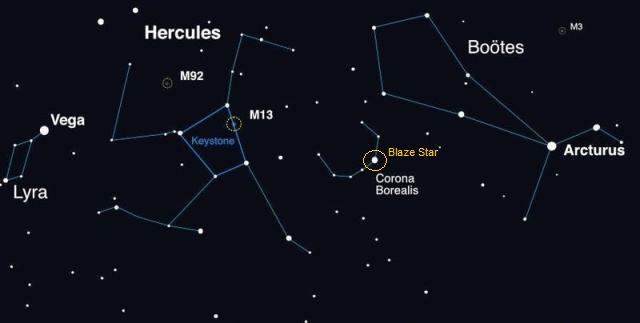Note4Students
From UPSC perspective, the following things are important :
Prelims level: Blaze Star and its location
Why in the News?
- NASA predicts the dim star T Coronae Borealis will become visible to the naked eye by September 2024, reaching brightness comparable to Polaris.
- A dim star known as the “Blaze Star,” officially designated as T Coronae Borealis (T CrB), located 3,000 light-years from our solar system, is set to become visible to the naked eye for the first time since 1946.
About the Blaze Star
|
Understanding the Blaze Star Phenomenon
- The Blaze Star is a rare recurrent nova, a binary star system comprising a cool, red giant star and a smaller, hotter white dwarf star in orbit around each other.
- Every 80 years, the red giant transfers matter onto the white dwarf, triggering explosive phenomena.
- Historical observations suggest the Blaze Star is on the brink of another explosion, following similar brightness patterns observed before previous eruptions in 1866 and 1946.
- Precursor Signs: The star has been steadily brightening since 2015, followed by a visible dimming in March 2023, mirroring past eruption precursors.
Implications for Observation
- Peak Visibility: During its brightness peak, the Blaze Star is expected to be visible to the naked eye for several days, extending to just over a week with stargazing binoculars or a small telescope.
- Astronomical Insights: The impending eruption offers a unique opportunity for astronomers to observe and study this celestial event, providing valuable insights into stellar evolution and dynamics.
PYQ:[2013] Consider the following phenomena 1. Size of the sun at dusk 2. Colure of the sun at dawn 3. Moon being visible at dawn 4. Twinkle of stars in the sky 5. Polestar being visible in the sky Which of the above are optical illusions? (a) 1, 2 and 3 (b) 3, 4 and 5 (c) 1, 2 and 4 (d) 2, 3 and 5 |
Get an IAS/IPS ranker as your 1: 1 personal mentor for UPSC 2024

